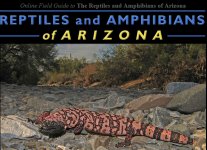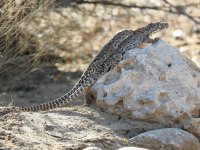| Range: |
 |
| Other Names: |
|
| Description: |
A large (up to 140 mm or 5.5" from snout to vent) lizard with a large, elongated head and a long, rounded tail. This lizard is capable of changing its coloration and pattern. At times it is light tan to golden yellow with dark brown spots on the back, tail, and hind limbs. The same individual can become dark gray-brown with thin, light, lace-like lines across the back, tail, and hind limbs. When exhibiting light coloration the lace-like lines melt into the light background color and the dark spots stand out. When exhibiting dark coloration the dark spots melt into the background and the light lines stand out. Both lines and spots are visible when the lizard is between the two coloration/pattern extremes. The scales are small and granular. Gravid females have bright orange or red markings on the neck, sides of body, and underside of tail. |
| Similar Species: |
Crotaphytus collaris has two black neck bands. All spiny lizards (Sceloporus) have larger, distinctly keeled, imbricate, and sometimes mucronate dorsal scales, and lack the transverse spotted and banded dorsal pattern. |
| Venom: |
none |
| Habitat: |
Found in desertscrub communities and Semidesert Grassland. Primarily an inhabitant of relatively flat, shrubby plains, valleys, and gently sloping bajadas with plenty of open space in which to run. |
| Behavior: |
It is usually encountered during the day in the partial shade of low shrubs and bushes. At top speeds it lifts the forelimbs off the ground and runs on its hind limbs. It does not hesitate to bite when captured and it can easily draw blood with its powerful jaws. It may also hiss or squeak when captured. Unlike many of our lizards it can not cast off and regenerate its tail.
|
| Hibernation: |
It hibernates during the cold months of winter and late fall. |
| Reproduction: |
The Long-nosed Leopard Lizard mates in spring and lays a clutch of up to 11 eggs in spring or summer. Hatchlings begin to emerge in August. |
| Diet: |
This aggressive predator uses its powerful jaws to capture grasshoppers, beetles, moths, bees, wasps, caterpillars, other insects, lizards (including other Long-nosed Leopard Lizards), snakes, and small mammals. It occasionally eats some plant material including leaves and berries. |
Adapted from account on reptilesofaz.org
Sources:


|



















